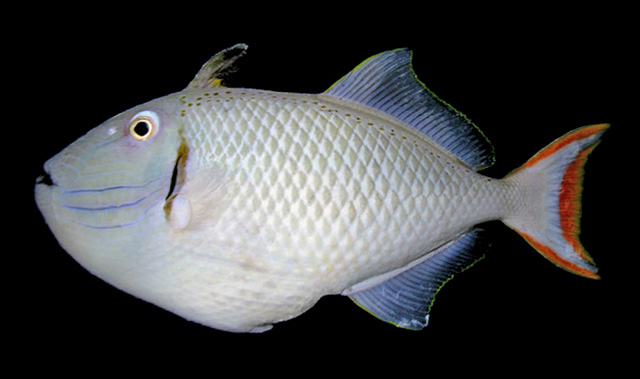| Balistidae (Triggerfishes) |
| 15.4 cm SL (male/unsexed) |
|
reef-associated; marine; depth range 90 - 100 m |
| Pacific Ocean: Kiribati (Line Islands). |
|
Dorsal spines (total): 3-3; Dorsal soft rays (total): 29-29; Anal soft rays: 25-25; Vertebrae: 18-18. This species is distinguished by the following characters: 3 pigmented cheek grooves; low body scale rows count 34 (33-35) vs. 39 or more; small size, 15.4 cm SL vs. over 22.5 cm SL; and a colour pattern of scattered dark spots sub-dorsally and without other spots or line on the body.
Description: dorsal and ventral profiles of head strongly convex; greatest depth of body 49 (45-50); pectoral rays 13 (rarely 14); head scale rows 18 (17-18); 3 longitudinal slightly diagonal darkly pigmented grooves on head following border of scale rows, running from behind and below corner of the mouth, converging slightly as they pass posteriorly, and nearly reaching gill opening and upper pectoral base. Colour when alive pearly gray or with light brownish cast, slightly whiter ventrally on body with faint light bluish cast to head (when viewed underwater, overall color appears light blue-gray); irregular honey-brown spots sub-dorsally on body in several irregular rows starting anteriorly at the origin of the first dorsal spine and becoming an irregular row before origin of the second dorsal and ending posteriorly with a few scattered spots on the caudal peduncle; caudal fin with reddish upper and lower margins, a broad reddish crescent posteriorly in fin but not extending to upper and lower margins, a light bluish area forming a diffuse crescent in the center of the fin (Ref. 94129). |
| This species is relatively abundant within its depth range, on coral rubble and holes adjacent to deeper drop-offs (below a thermocline) at several localities of the coasts of Kiritimati (Christmas Island). It has always been observed near the reef substratum, where it would seek shelter when approached (Ref. 94129). |
|
Data deficient (DD); Date assessed: 17 January 2022 Ref. (130435)
|
| harmless |
Source and more info: www.fishbase.org. For personal, classroom, and other internal use only. Not for publication.

